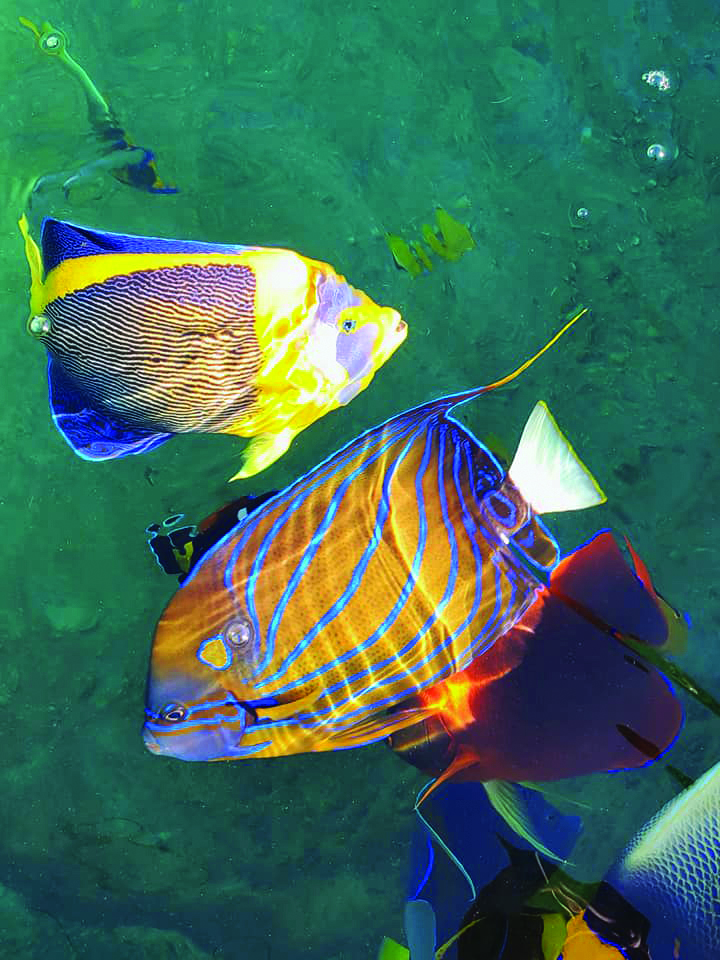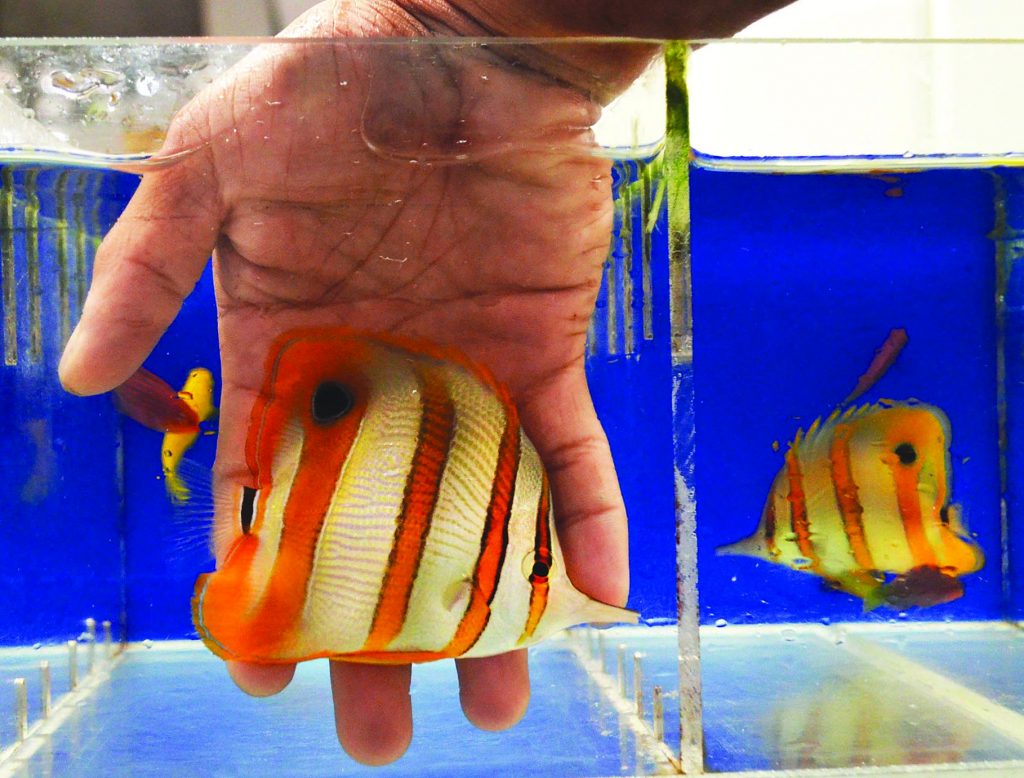WITH JONAH VAN BEIJNEN
The billion-dollar marine aquarium trade has a mixed reputation because most Fishes and Invertebrates are still plucked wild from the world’s Coral reefs, particularly in the Philippines and Indonesia. Several big pioneers are now propagating Marine Fishes on a commercial scale, proving how those in the industry can delve into the colorful world of Fish companions.
Since the 1960s, the Philippines and Indonesia have exported the vast majority of Marine Fishes for aquariums, including colorful Clownfish, curious-looking Seahorses, and graceful Angelfish. However, overfishing and coastal degradation have caused local Fish populations to plummet. After the movie Finding Nemo premiered in 2003, for instance, soaring demand caused Clownfish population sizes to plunge by as much as 75% in some Coral reefs.

DESIGNER ANGELFISH. Designer Angelfish at the Bali Aquarich facility in Indonesia. Like farmed Freshwater Fishes selectively-bred for color over many years (Goldfish and Koi were once just dark green Fishes), it is now possible to create color morphs for Marine Fishes, adding to their value and rarity. (Bali Aquarich)
CULTURE ISSUES
The culture of marine ornamentals – including Fishes, Crustaceans, and Corals – for the aquarium hobbyist segment is a $5 billion industry. It is a relatively new sector and is often ignored by mainstream aquaculture producers, yet it pushes the boundaries of aquaculture by exploring the culture of new species and improved culture methods. As well as providing considerable profit margins, it also provides huge opportunities for coastal communities in developing countries.
Best Alternatives Campaign’s Gregg Yan and VB Consultancy’s Jonah van Beijnen interviewed leading experts on ornamental marine aquaculture. Till Deuss, the founder and CEO of Bocas Mariculture in Panama, focuses on Caribbean Fishes and Invertebrates, while tackling environmental conservation and livelihood generation for local communities.
Meanwhile, Wen-Ping Su, founder and owner of Bali Aquarich and a veritable legend in the sector, draws on his own experience, having founded a hatchery for Milkfish, Grouper, and other Fishes in Indonesia before diversifying into the production of the region’s ornamental Marine Fish. Wen-Ping is renowned for producing hybrid and pureblood Angelfish, plus a variety of extremely colourful customised Clownfish. Between them, they provide numerous valuable insights into the sector.

HARMFUL VERSUS HELPFUL
Although ornamental Freshwater Fishes, such as Goldfish and Koi, are extensively cultured, particularly in Southeast Asia and Taiwan, Marine Fishes and Invertebrates are still mostly caught in the wild. It’s estimated that some 50 million Coral reef animals (including Fishes, Corals, and other Invertebrates) are annually caught and sold to marine aquarium hobbyists.
Most of the popular marine ornamentals hail from warm tropical regions, such as Southeast Asia (particularly the Philippines and Indonesia), the Caribbean, and the Red Sea. In the past, many were caught using destructive fishing methods like sodium cyanide. However, hand-net fishing initiatives and better management practices have fortunately changed the seascape.
With the current degraded status of most of the world’s reefs due to increasing sea temperatures, stronger storms, pollution, and overfishing, depleting reefs of what wild stocks remain does little to let reefs recover. In addition, the long supply chains often minimize benefits for local fishers. For instance, a Filipino fisherman receives roughly Php 10 for a Clownfish retailing for around Php 1000.
NUMBERS GAME
Though the production of sea animals for human consumption has been in the spotlight for several decades, with investors willing to back a wide range of business proposals, the ornamental aquaculture industry is relatively unknown. This is not because of its lack of potential: The global aquarium industry is currently valued at $12 billion and, with a CAGR of 7%, is expected to reach almost $20 billion by 2026.
The total sale of ornamental Freshwater and Marine Fishes amounts to an annual global turnover of about $5 billion. In the United States alone, 15 million households own aquaria, with 2.5 million housing Marine Fishes. Approximately 20% of the total trade consists of marine species.

Asia-based Best Alternatives and Europe-based VB Consultancy work to promote sustainable solutions for the environment.
STEADY PROGRESS
This is precisely the angle that Deuss and his company Bocas Mariculture approach the business from their base in Panama. Originally from Germany, Deuss started keeping and breeding Fishes while still a boy. His impressive track record includes breeding well over 60 Marine Finfish and 20 Crustacean species in captivity, including several world firsts.
These successes brought him first to Colombia to collaborate with the Institute of Marine and Coastal Research, and he also managed marine ornamental farms and related projects in Palau, Micronesia, and French Polynesia.

While visiting Panama for a project with the Smithsonian Tropical Research Institute, he noticed its fantastic marine environment, but also realized how overfishing was rampant and that local coastal communities were struggling to make ends meet. He saw an opportunity to sustainably breed marine species for the aquarium trade while simultaneously generating employment for local communities.
It was challenging to convince the authorities, but after a research permit and 10 years of groundwork, he finally received a commercial export permit in 2019, a first for Panama and most of the region.
His hatchery is now mainly producing small Reef Fish species in high demand in Europe and the United States. While the Fishes are grown in the hatchery, the company also produces soft, colorful Corals, which are cultured in coastal sites, under the watch of local fishing families.
Asia-based Best Alternatives and Europe-based VB Consultancy work to promote sustainable solutions for the environment.
INCREASED INTEREST IN SUSTAINABILITY
It took some time for captive-bred ornamental Marine Fishes to compete with wild-caught ones, but that trend is now reversing. As Deuss explains, “The market is rapidly changing. There’s increasing interest from buyers who prefer sustainably produced [Fishes].”
With consumers becoming more environmentally conscious, wholesalers and retailers are increasingly pressured to meet the requirements of their customers, while also adapting to policy shifts with tighter restrictions on the trade in wild Fishes, according to Deuss. Some national governments are even discussing potential bans on the trade in wild-caught Marine Fishes.
“In the last decade, general awareness about the aquarium trade and its role in the conservation of Coral reefs has been rising,” explains Deuss. As a consequence, he says the trade often faces pressure from well-meaning but ill-informed environmental groups which would like to ban the trade completely.
Wen-Ping Su agrees.
“The current market is affected by the interaction of two forces. The drop in
the price of hardware such as aquarium equipment has reduced the entry gate, so more consumers have entered. Simultaneously, the awareness campaign of environmentalists and changing government policies also affected the market and trade in favor of companies who produce [Fishes] sustainably,” he says.
Both companies see sustainability as essential to their branding. “Our entire business model relies on sustainability and we want our customers to be aware of this,” says Deuss. “We realize that there’s a growing number of hobbyists who are conscious about the environment and who want to buy from a trustworthy and truly sustainable source. We provide a label to certify that our animals are cultured.
It is also important to note that cultured species are in general much healthier and hardier than wild-caught [Fishes] from unknown sources, being better adapted to aquarium conditions and people. We trust that customers acknowledge the environmental and economic advantages of sustainably-grown [Fishes] and are willing to pay a small premium for them.”

WILD-CAUGHT. The vast majority of Marine Fishes for aquariums are caught wild in tropical Coral reefs in the Philippines, Indonesia, and other countries. Shifting to farm-bred Fishes is now possible as the technology needed to breed and raise Marine Fishes has now been developed. (Gregg Yan | Best Alternatives)
SPECIES SELECTION
“Although many people talk about environmental protection, buying trends still show that the majority of buyers choose the cheapest Fishes,” reveals Wen-Ping. For this reason, his company’s strategy has been to expand the market by introducing new species or varieties and setting prices.
As such, Bali Aquarich focuses on producing high-value species, particularly highly-prized Marine Angelfish. Wild specimens retail for several hundred dollars or more but don’t adjust well to captivity, easily succumbing to stress or disease. Captive-bred Angelfish, on the other hand, are very hardy, being completely adjusted to a captive environment with artificial food, thus providing better value for money, according to Wen-Ping. Bali Aquarich has also developed several hybrids of Marine Angelfish, giving the company an extremely valuable selling point.
Bocas Mariculture, on the other hand, focuses more on smaller species, suitable for what hobbyists term nanotanks and micro-minireefs. Deuss has picked species which are in high demand, but for which no sustainably farmed alternatives are available. Focal species include Royal Gramma (Gramma loreto), small Angelfish species, Gobies, Peppermint Shrimp (Lysmata jundalini) and a variety of soft Corals like Zoanthids and Corallimorphs.
PRODUCTION APPROACHES AND TECHNOLOGIES
While a Salmon hatchery, for example, focuses solely on breeding Salmon and tackling Salmon-specific problems, ornamental breeders often produce 10 to 20 or more species simultaneously, each with its own challenges to overcome — a mind-boggling task to perform.
Wen-Ping explains that the production of ornamental and food Fishes require completely different approaches. Food fishes can be produced and sold in large quantities. In contrast, ornamental Fish sales are typically small and diverse. “Generally, ornamental [Fishes] require much higher water quality, environment and nutrition than food [Fishes],” he says.
“Aquariums are still seen as a non-essential hobby so it’s still relatively hard to find support for the production of marine ornamentals,” says Deuss, who believes that food producers often benefit from state-driven research to breed only a few species, while most ornamental Fish breeders follow a bottom- up approach for a wide range of species.
Deuss acknowledges that the marine ornamental aquaculture industry is still in its infancy and the vast majority of species have no breeding protocols for commercial-level production. Aquaculturists are thus forced to develop new breeding techniques or adopt existing technologies for new species.
“For a long time, certain species were considered impossible to breed, but a lot of breakthroughs have been made in the past decade or so, particularly in culturing Copepods, [eaten by] marine ornamentals,” he reflects. As many different species are produced at a single hatchery, the environment is highly dynamic, innovative, and competitive.

MARINE AQUARIUM. Marine Fishes, Shrimp, and Corals on display at an aquarium in Manila. Keeping all types of Corals – whether hard or soft – is now illegal in the Philippines. Shifting to Coral replicas made of rubber or silicone is a safe and affordable alternative. (Gregg Yan | Best Alternatives)
TECH PRACTICES
Aside from developing broodstock that can spawn in captivity, a key component for innovation is to find live feed sources for recently-hatched larvae. Feeds should match their nutritional requirements to ensure proper development and survival. Deuss has put a lot of effort into this and he proudly explains that besides producing several species of algae and different strains of Rotifers, he personally isolated several local Copepod species.
Copepods are zooplankton serving as important feed sources for many Marine Finfish but are much harder to culture then Rotifers. He now cultures these Copepods in sufficient quantities for his hatchery, while also working to culture several types of Ciliates and Micro-Worms as additional food sources.
Wen-Ping has developed similar technology in-house and now has two different Copepod production systems while also developing a modular production system for various Fish fry.
“There are many species with peculiar breeding patterns, nutrition, and water quality requirements. The conventional practices used by hatchery operators for food [Fishes] cannot meet the needs of many larvae of ornamental [Marine Fishes]. The bigger the eggs, the bigger the larvae and fry, typically making it easier to raise juvenile [Fishes]. The average egg size for [Marine Fishes bred as food] is about one millimeter, with Salmon eggs even reaching five millimeters. However, the eggs of some ornamental [Fishes] are just a third of a millimeter.”
THE FUTURE
Looking ahead, both men think that their ventures could play important roles in conservation.
“The imminent global collapse of Coral reef ecosystems is increasing the importance of aquaculture, not just to supply the aquarium trade, but also to possibly reintroduce species which might become extinct in the wild. Many reef species might only exist in aquaria in the future,” predicts Deuss.
His company is in the process of establishing additional hatching capacity and setting up new sales channels to provide sustainably-bred species globally. His team is also working to culture an extremely colorful species of Fish, almost unknown in the aquarium trade but which is perfectly suited to small tanks, the details of which will soon be revealed.
Wen-Ping also sees a bright future for his company, which is currently expanding production capacity and developing new species for commercial-level production. He also has exciting news as he has been nominated by Aquarama for the 2019 Ornamental Fish High Technology Excellence Award, with the event taking place in May 2021 in Guangzhou, China.
Mainstream food Fish farmers currently culturing Bangus, Lapu-Lapu, and other Marine Fishes can learn a lot from ornamental Fish and Invertebrate breeders. It would be great to see more collaboration between the two sectors in the future.
While the farming of marine ornamentals might not reach the same scale as conventional food Fish production, the trade is starting to reward pioneers with considerable returns, while also benefiting local communities and, of course, our oceans. (Earlier version of this article was published on the Fish site.)






